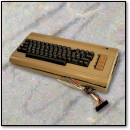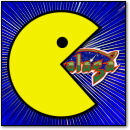Archive for the 'Retro Scan of the Week' Category
[ Retro Scan of the Week ] An Analog Christmas
Monday, December 19th, 2011[ Retro Scan of the Week ] Merry Christmas From Nintendo, 1988
Monday, December 12th, 2011 I see great things in your future.
I see great things in your future.
I recently scanned this lovely Nintendo-sponsored Christmas greeting off the back of a 1988 issue of Nintendo Power. You can see the complete magazine back in the full-sized version of the scan (click the image above to see it). In that larger scan, names and addresses have been changed to protect the innocent.
Kinda gives you that warm and fuzzy feeling, doesn’t it?
Discussion Topic of the Week: Did you ever receive a NES (or even a NES game) for Christmas? Tell us about your memories of the occasion.
[ Retro Scan of the Week ] Sharp Pocket Locker
Monday, December 5th, 2011 Two teen girls compare notes on vampires that attend their high school.
Two teen girls compare notes on vampires that attend their high school.
Ah, the dedicated electronic pocket organizer — an ever-present, seemingly useful device for want of a market.
Since the early 1980s, electronics manufacturers have produced pocket-sized computer gadgets that store databases of phone numbers, addresses, calendar appointments, and not much else. These electronic organizers reached their peak (in terms of number of devices in the market) in the mid-1990s. At that time, the technology involved became cheap enough to market to kids.
Despite manufacturers’ best efforts, such devices have continuously failed to gain widespread use for a simple reason: none have demonstrably improved upon the paper address book. Not even the socially-hungry teen girl market, as targeted by Sharp in this 1995 ad for the Pocket Locker, could push them into the mainstream.
It was only when manufacturers rolled electronic organizer functionality into a more general-purpose device (think palmtop computer, PalmPilot) that the idea of electronically maintaining personal contact records in a mobile setting took off. Address books, calendars, and phone databases became separate programs that lived in a larger ecosystem of applications that could be run on the device.
Most palmtop computer-style PDAs offered significant advantages over the paper organizer. They synchronized with PCs to back up information, and they could use the stored data in conjunction with other programs for more useful effect — for example, you could actually email someone directly from a record stored in your digital address book.
Contrast that experience to the dedicated pocket organizer model, where the the information you entered became trapped in a tiny plastic box with a crummy display and a kludgy interface that would lose its memory if its batteries ran out.
Today, the organizer-as-software clearly won over dedicated units, and anyone with a mobile phone now carries an organizer software suite in their pocket. It’s only one of many functions that cellphones have absorbed on their quest to become the ultimate multipurpose pocket device.
Discussion Topic of the Week: Have you ever used a dedicated electronic pocket organizer device? Tell us about it.
[ Retro Scan of the Week ] Super NES on Ice
Monday, November 28th, 2011[ Retro Scan of the Week ] Family Computing
Monday, November 21st, 2011[ Retro Scan of the Week ] Beyond Zork
Monday, November 14th, 2011 That spot in the upper left is actually mold that grew on the paper.
That spot in the upper left is actually mold that grew on the paper.
When is a text adventure game not a text adventure game? When it’s Beyond Zork: The Coconut of Quendor.
Infocom’s fourth entry in the Zork series (actually the 8th if you count the related Enchanter series and Wishbringer) combined interactive fiction with light RPG elements such as equipment, stat sheets, an on-screen map, and character leveling to create a unique game that may be best compared to a single player MUD (a SUD?).
Beyond Zork sports procedurally generated maps in some areas, so replay value is theoretically infinite. But randomness is a double-edged sword in this case: its magic items move around between saves and loads, and that can frustratingly break the suspension of disbelief (i.e. you see it, you die, you come back, and it’s gone). Still, Beyond Zork is an amazing game that deserves more attention than it usually gets.
Discussion Topic of the Week: What’s your favorite entry in the Zork series? Every Zork-related game counts.
[ Retro Scan of the Week ] Father and Son at the Atari
Monday, November 7th, 2011 Stranded in a jungle with only a desk, a cup of coffee, and an Atari 800.
Stranded in a jungle with only a desk, a cup of coffee, and an Atari 800.
I’ve always enjoyed the illustration style found on the earliest Atari 400/800 instruction manuals, such as the one here for the Basic Reference Manual. I’ve included an extra large scan this time so you can enjoy the detail up close.
Does anybody know the name of the artist who did them? I’ll admit I haven’t looked very hard.
By the way, this manual was written by River Raid creator Carol Shaw.
Discussion Topic of the Week: Have you ever programmed with your dad? Tell us about it.
[ Retro Scan of the Week ] Dungeon Master Duo
Monday, October 31st, 2011 Dungeon Master: Theron’s Quest – The video game for brutal dictators.
Dungeon Master: Theron’s Quest – The video game for brutal dictators.
Discussion Topic of the Week: Have you ever dressed as a video game character for Halloween? Tell us about it.
[ Retro Scan of the Week ] The Daisy Wheel
Monday, October 24th, 2011Here’s an interesting piece of obsolete technology — a plastic Lanier daisy wheel for a daisy wheel printer. Its actual size is about three inches in diameter.
There was a time when having a “letter quality” impact printer meant that the machine printed text using pre-formed, typewriter-like type elements. Some printers held these elements in the shape of a cylinder or a sphere, but in the case of the daisy wheel printer, the character forms projected from a central wheel in a shape that resembled a daisy flower.
Daisy wheel printers produced text by rotating the wheel to the proper character spoke and striking the back of it against an ink ribbon, which would leave a mark on the underlying paper.
Each daisy wheel rendered a different font (or type size), and thus fonts could be changed as easily as replacing one wheel with another. In this case, you’re looking at a wheel for the font called “Prestige Elite 12,” but printer makers sold dozens of other font wheels, such as those for Courier 10 or Cubic 15.
The daisy wheel method reproduced fonts using a dramatically different technique than, say, dot-matrix printers, which used a single matrix of metal pins to form various characters.
Laser and inkjet printers, which produce much less noise and use software-based fonts, made impact printers thoroughly obsolete for every-day PC use by the late 1980s (though stragglers used dot-matrix printers well into the mid-1990s due to lower prices). Even so, impact printers still reign supreme in specialized applications that require physical force, such as document reproduction via carbon copy paper.
Discussion Topic of the Week: Have you ever used a daisy wheel printer? Tell us about it.










